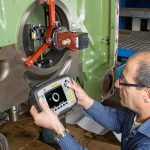 AI in Predictive Maintenance refers to the use of advanced machine learning algorithms to optimize maintenance schedules, predict equipment failures and prevent downtime in various industries. By analyzing real-time data and historical patterns, AI can identify potential equipment issues before they occur, allowing for proactive maintenance and reducing costly unplanned downtime. AI in Predictive Maintenance is revolutionizing the way businesses approach equipment maintenance, enabling them to achieve maximum uptime and efficiency.
AI in Predictive Maintenance refers to the use of advanced machine learning algorithms to optimize maintenance schedules, predict equipment failures and prevent downtime in various industries. By analyzing real-time data and historical patterns, AI can identify potential equipment issues before they occur, allowing for proactive maintenance and reducing costly unplanned downtime. AI in Predictive Maintenance is revolutionizing the way businesses approach equipment maintenance, enabling them to achieve maximum uptime and efficiency.
What Is Predictive Maintenance?

Predictive maintenance is a field in artificial intelligence and machine learning. It refers to the capacity to use large amounts of data to foresee and address prospective problems before they result in breakdowns in operations, processes, services, or systems.
Businesses can foresee when and where potential service breakdowns might happen. With this data, they can move to respond to them to stop any service interruptions by having robust predictive maintenance solutions in place.
It is also referred to as condition-based maintenance, and it was used since the 1990s by manufacturers to streamline their business practices.
Artificial Intelligence in Maintenance
Manufacturers are turning to digitalization to alter their operations. This is in response to the increased need for quality and efficiency in production and manufacturing processes across industries.
Maintenance professionals now have access to vast amounts of data thanks to advances in digital technology. They are looking for tools and procedures to assist them go through this data and derive insightful information.
The most cutting-edge instrument that has the capacity to sift through enormous volumes of complex machine data. It can also deliver crucial knowledge to enhance maintenance operations is artificial intelligence. To deliver real-time insights on machine health, it analyzes various types of machine-generated data using machine learning techniques.
Automated AI-Based Predictive Maintenance

Automated AI-based predictive maintenance solutions allow businesses to avoid asset breakdowns and unplanned downtime. These solutions include IIoT hardware that links physical assets to one another. It also has a sophisticated analytics platform that examines intricate machine data to forecast breakdowns and stop unscheduled downtime.
Solutions for predictive maintenance powered by AI enable proactive asset maintenance and remote condition monitoring. An automated AI-based predictive maintenance system’s goal is to maintain and enhance the functionality of crucial industrial assets. It can lead to a decrease in failures, a reduction in downtime, an increase in productivity, and enhanced workplace safety.
The AI-based system analyzes machine output data, including historical performance and real-time contextual data. Then, it alerts maintenance and reliability professionals to the maintenance requirements of various equipment sets.
Predictive Maintenance vs. Preventive Maintenance
Similar to preventive maintenance is predictive maintenance. These are both varieties of planned maintenance. Preventative maintenance entails using broad best practices for equipment repair. It does not consider the use of the item and its peculiarities. Predictive maintenance creates tailored forecasts of imminent faults based on actual measured usage, operational circumstances, and equipment feedback.
Importance of AI in Preventive Maintenance
Organizations may keep vital assets by implementing predictive maintenance services, ensuring that systems continue to function. Instead of responding to problems as they happen, firms can use their current data to stay ahead of upcoming failures. They can then address them in a proactive manner.
This comprises:
- Decreasing expenses through fewer redundant inspections, less unscheduled downtime, less ineffective preventative maintenance procedures.
- Enhanced productivity and lower labor and material costs result in cost savings.
- increased performance and longer equipment life reduce equipment lifetime costs.
- indirect advantages including higher quality, less rework, fewer faults, enhanced safety, and higher energy efficiency.
Benefits of AI in maintenance in Preventive Maintenance
Improved equipment reliability
The capacity to identify flaws before they occur is the first significant advantage of artificial intelligence in predictive maintenance.
This implies that businesses can stop expensive equipment breakdowns in their tracks. This enables businesses to cut expenditures related to routine maintenance procedures.
Increased equipment uptime and reduced downtime
AI-based predictive maintenance systems also assist businesses in preventing production losses. These issues come from malfunctioning machinery. Businesses will spend less on repairs, which concerns hiring outside service providers and technicians, to fix their machinery.
Improved safety
By gathering data from the machines in complicated and challenging-to-reach spots, it also increases the working safety of engineers and technicians.
Reduced maintenance costs
It saves businesses time by removing the need for manual inspection checks and visits to the shop floor for troubleshooting.
Better decision-making
AI solutions can identify regions that could use particular enhancements to increase production results. Artificial intelligence systems can identify process patterns that result in inefficiencies and work out how to fix them using data from IIoT-connected devices and sensors.
To help teams more easily develop targeted PPM schedules, AI can also monitor performance over time to identify where failures are most likely to occur.
Improved overall efficiency and productivity
AI is far more economical than conventional maintenance techniques and other types of redundancy, such as backups or replacements.
How is AI used in manufacturing and maintenance
Improved overall equipment effectiveness (OEE)
AI solutions can assist businesses in identifying and resolving points of friction by evaluating production processes from beginning to end.
Artificial intelligence frameworks might find a mismatch between the two stages of component assembly. The first stage might be able to handle 10 components per hour, the second stage would only be able to manage five, which would result in lost productivity.
Equipped with this knowledge, businesses might buy and install extra machinery for the second step, increasing the overall effectiveness of the equipment.
Total productive maintenance (TPM)
TPM encourages participation in maintenance from all staff members, not only the maintenance crews, in order to enhance operations.
Front-line employees, equipment operators, supervisors, and engineers fall under this category. Companies can increase their chances of finding possible issues by involving more people in maintenance operations.
Nevertheless, achieving this goal necessitates the employment of AI systems that can gather maintenance data and make it available to workers.





